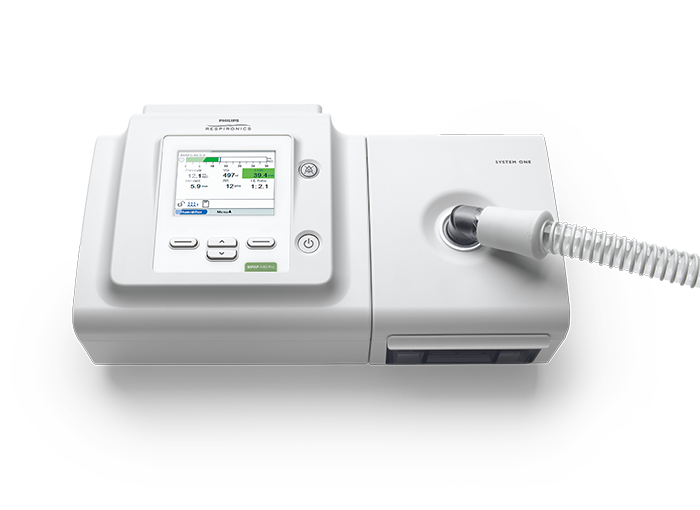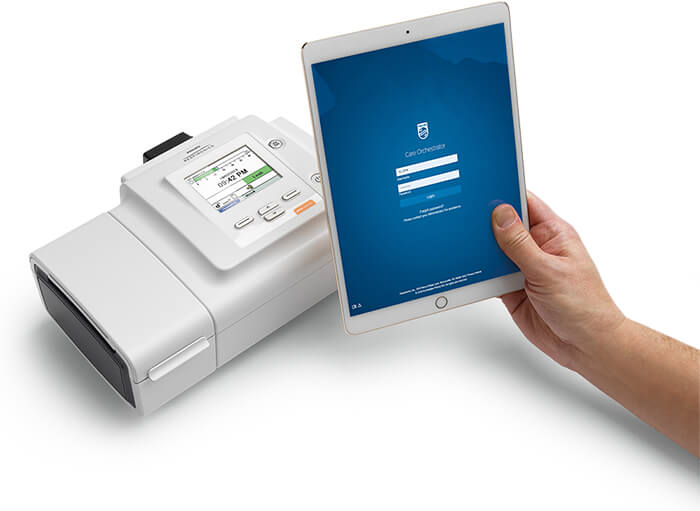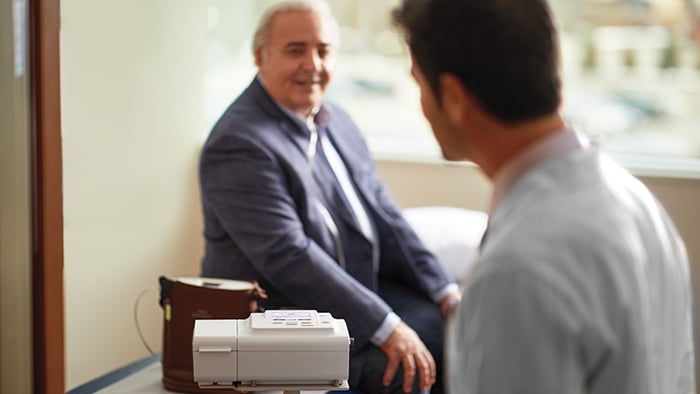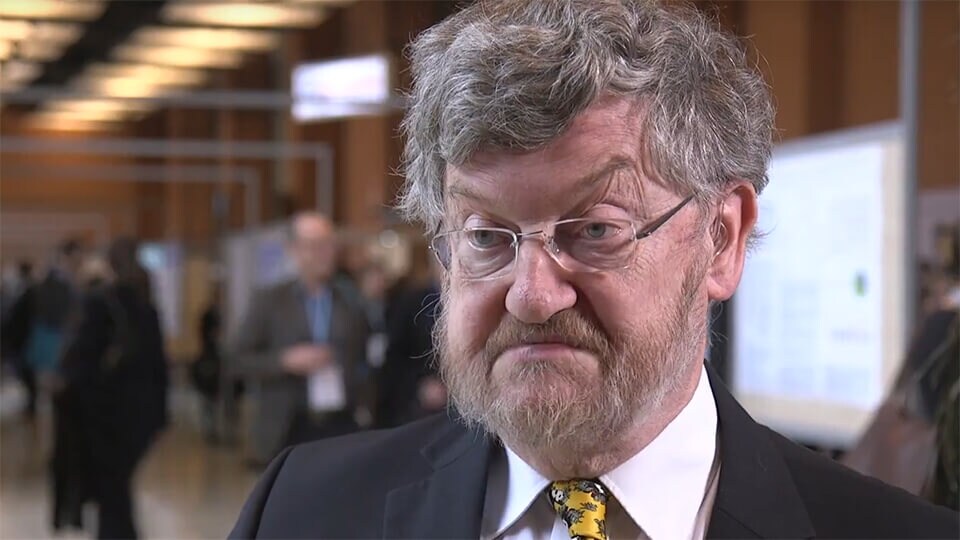Talk to a sales representative
Introducing BiPAP A40 Pro
The BiPAP A40 Pro bi-level ventilator treats patients suffering from respiratory insufficiency. Its advanced functionality is designed to reduce patient setup times and it automatically adjusts therapy to deliver the lowest possible pressure throughout changing conditions.

To optimise patient management, BiPAP A40 Pro is built to connect from diagnostic work to at-home therapy. BiPAP A40 Pro automatically integrates with sleep lab and home diagnostic systems, as well as with Philips Respironics Care Orchestrator, so you can coordinate care and resolve patient concerns remotely.
BiPAP A40 EFL coming soon
The BiPAP A40 EFL is the first and only purpose-built COPD noninvasive ventilation method designed to screen, detect and abolish EFL.
Expiratory Flow Limitation (EFL) is difficult to diagnose and is often undetected and undertreated, despite affecting >60% of COPD patients.1,2* Many patients with EFL experience hyperinflation, which can increase work of breathing at rest. Left untreated, many moderate-to-severe patients may become hypercapnic. BiPAP A40 EFL identifies EFL and dynamically and automatically optimises therapy pressure to reduce your patients’ work of breathing. With BiPAP A40 EFL, you can provide comfortable at-home COPD ventilation therapy that patients can start with and stay with – and transform management of hypercapnic COPD.3,4†

Stay connected to patients and care teams along the care pathway
The BiPAP A40 EFL connected platform streamlines diagnostic work through auto-integration with sleep lab and home diagnostic systems. The BiPAP A40 EFL is built to connect to Philips Respironics Care Orchestrator, providing you with an easy way to gather, store, manage and view therapy and compliance data, and optimise patients’ overall ventilation therapy. The BiPAP A40 EFL delivers actionable patient data5 directly to care teams, so everyone can work together to prioritise patients who most need intervention.
Philips Live! Webinars
Expiratory Flow Limitation (EFL) webinar series
Discover our three part series all about EFL in collaboration with Dr. Biswajit Chakrabarti, (Consultant Respiratory Physician at University Hospital, Aintree) to support clinicians to manage and treat patients with chronic COPD



Download the latest clinical data on managing EFL.
Download the latest clinical data on managing EFL. See new insights on the importance of treating EFL in hypercapnic COPD patients from these clinical papers.
What is Expiratory Flow Limitation?
Dr. Swapna Mandal, BSc, MBBS, MRCP, Consultant Respiratory Physician, Royal Free Hospital, London, UK Summary: COPD is defined by irreversible airflow limitation that is progressive and causes a reduction in exercise capacity and quality of life. Some COPD patients can develop EFL, which can result in hyperinflation that leads to worsening breathlessness, exercise limitation, and potentially, respiratory failure. Philips Respironics BiPAP A40 EFL noninvasive ventilator can abolish EFL on a breath-by-breath basis and may reduce hyperinflation and the patient’s work of breathing.
Why and when COPD patients should be evaluated (screened) and treated for expiratory flow limitation (EFL)
Dr. Michael Polkey MD, PhD, Consultant Chest Physician, Royal Brompton Hospital & Harefield Hospital, London, UK Summary: EFL is a feature of COPD that can lead to hyperinflation and breathlessness. This paper focuses on noninvasive ventilation users and how EFL is best overcome by titrating the level of applied expiratory positive airway pressure (EPAP) to overcome EFL, thus relieving hyperinflation and air trapping. Further, the paper addresses how EFL can increase during rest due to the effects of posture, disease progression, intercurrent inflammation, and/or exacerbation. With the next generation of ventilators, clinicians will be able to detect and measure EFL on a breath-by-breath basis and titrate EPAP to overcome EFL.
The role of forced oscillation technique in ventilation
Bob Romano, Biomedical Engineer, Philips, Monroeville, U.S. Summary: This paper highlights how the forced oscillation technique (FOT) can provide an objective, noninvasive, and repeatable measure of bronchial disorders in adults and children. Philips Respironics has utilized this technology to develop a noninvasive ventilator that delivers FOT to continually assess a patient’s pulmonary mechanics and level of EFL. When this technology is incorporated into a noninvasive ventilator, clinicians can screen and treat EFL on a breath-by-breath basis without excess respiratory interventions or forced breathing.
Prevalence and impact of expiratory flow limitation in COPD with a therapy focus on Hypercapnic COPD
Dr. Eui-Sik Suh, MBBS, MChem(Oxon), PhD, FRCP, Consultant Physician in Respiratory and Ventilation Medicine, Lane Fox Respiratory Unit, Guy’s and St Thomas’ NHS Foundation Trust, London, UK Summary: EFL is a condition that is common in COPD and drives dynamic hyperinflation and dyspnea, both of which affect quality of life, exercise capacity, hospitalizations and mortality rates. In moderate-to-severe COPD patients, EFL may increase the possibility of chronic hypercapnia. The current options for detecting EFL are limited by their invasive and time-consuming natures; however, the forced oscillation technique (FOT) has been shown to be a viable screening and therapeutic option for EFL during noninvasive ventilation therapy. Abolishing EFL could result in an improvement in dyspnea, improved exercise capacity, improved quality of life and a decrease in COPD exacerbations and hospitalizations.
Expiratory flow limitation: Overview, detection and an application to abolish EFL
Raffaele Dellacà, Associate Professor – Department of Bioengineering, Politecnico di Milano, Milan, Italy Summary: In patients with chronic obstructive pulmonary disease (COPD), airway obstruction requires increased work of breathing and results in respiratory muscle fatigue and the potential for respiratory failure. These patients also experience expiratory flow limitation (EFL), which is characterized by the inability to increase expiratory flow by increasing alveolar pressure. This paper highlights that forced oscillation technique (FOT) is a simple and minimally invasive method used to screen for and treat EFL by studying the resistance and reactance of the respiratory system. FOT is designed for continuous and automatic monitoring during noninvasive ventilation, which allows for the real-time automatic adjustment of ventilation pressures while administering this therapy.
Watch experts discuss EFL

Satellite Symposium Highlights: New Noninvasive COPD Screening of EFL Within Home Therapy
This educational activity recording features an interview with Dr. David White, Medical Director, Philips Sleep & Respiratory Care. Filmed at the ERCA–JIVD 3rd Joint International Meeting, Lyon, France, March 2018.

Satellite Symposium Highlights: New Noninvasive COPD Screening of EFL Within Home Therapy
This educational activity recording features an interview with Dr. Peter Calverley, Professor of Respiratory Medicine and Honorary Consultant Respiratory Physician at Aintree Hospitals, Liverpool, UK. Filmed at the ERCA–JIVD 3rd Joint International Meeting, Lyon, France, March 2018.
*COPD patients with a DeltaXrs ≥ upper normal limit (ULN) †Context: Stable and ventilated hypercapnic COPD patients. References: 1. Dellacá RL, Santus P, Aliverti A, et al. Detection of expiratory flow limitation in COPD using the forced oscillation technique. Eur Respir J. 2004;23(2):232-240. 2. Aarli BB, Calverley PM, Jensen RL, et al. The association of tidal EFL with exercise performance, exacerbations, and death in COPD. Int J Chron Obstruct Pulm Dis. 2017;12:2179-2188. 3. Competitive market study to determine competitive Bi-Level devices intent and COPD ventilation relevance, Jim McKenzie, Philips Respironics, March 2019 . 4. Suh ES, Pompilio P, Mandal S, et al. Abolition of expiratory flow limitation in severe chronic obstructive pulmonary disease (COPD) using auto-titrating continuous positive airway pressure based on the measurement of within-breath airway reactance determined by the forced oscillation technique. Poster presented at: American Thoracic Society 2014 International Conference: San Diego, CA; May 19, 2014. 5. Key ventilation parameters, alarm data, device performance and patient usage.

